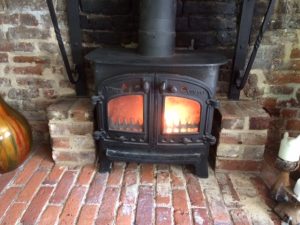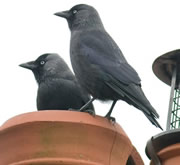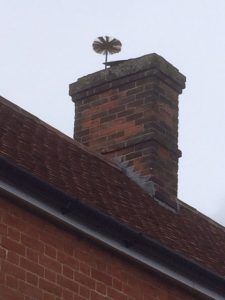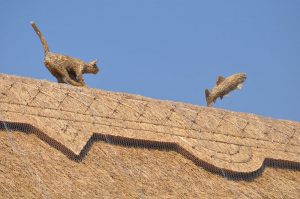I recently swept the chimney for this small Coalbrookdale Multi-Fuel stove and encountered a number of problems that had developed in the chimney over an extended period of time. It transpired that the house had recently been purchased by new owners and that the previous owners had probably never had the chimney swept in all the time that they had resided at the property. This apparently was over a period of about 40 years, and it was highly likely that the stove had been there and in use over much of that time.
The stove itself was in relatively good condition, but was what I would term an old style installation; in that it was not lined, having a stove pipe that extended a short distance above the register plate and then ended inside the chimney. Consequently, this means that when the chimney is swept the upper surface of the register plate has to be cleaned off through the inspection hatches in the plate. This is because all the soot and material that is swept off the inside of the chimney falls down and lands on the register plate. This particular chimney had an approximately meter or so square void directly above the register plate before the chimney narrowed to about a foot square for the remainder of the stack (which was 11 and half meters tall).
Upon examination I found that the entire void in the chimney and for about a metre up the stack was completely full of compacted tar blocking the chimney. I removed this using rods and a pigs tail fitting; a process that took some time and which filled six and a half large trugs full of tar. I then found that four and a half meters up the stack there was a crows nest right up to the top of the stack. I again removed this this using rods and a the pigs tail fitting and the metal flail attachment, before I could sweep the chimney with a brush. A very time consuming process indeed.
The small Coalbrookdale Multi-Fuel stove is a rather attractive little stove and I still see one or two of the about on my rounds as well as some of the larger Coalbrookdale stoves. This is unusual as they have been out of production for some time now, as the Coalbrookdale company does not exist any more as they were taken over by Aga. Aga have replaced the small Coalbrookdale Multi-Fuel stove with their own Aga Little Wenlock stove. Contact http://www.agaliving.com
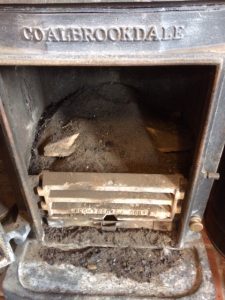


 My name is Paddy McKeown, I am a retired police officer (Detective Sergeant – Metropolitan Police), turned chimney sweep. I have completed training with ‘The Guild of Master Chimney Sweeps’, and Rod Tech UK (Power Sweeping).
My name is Paddy McKeown, I am a retired police officer (Detective Sergeant – Metropolitan Police), turned chimney sweep. I have completed training with ‘The Guild of Master Chimney Sweeps’, and Rod Tech UK (Power Sweeping).




